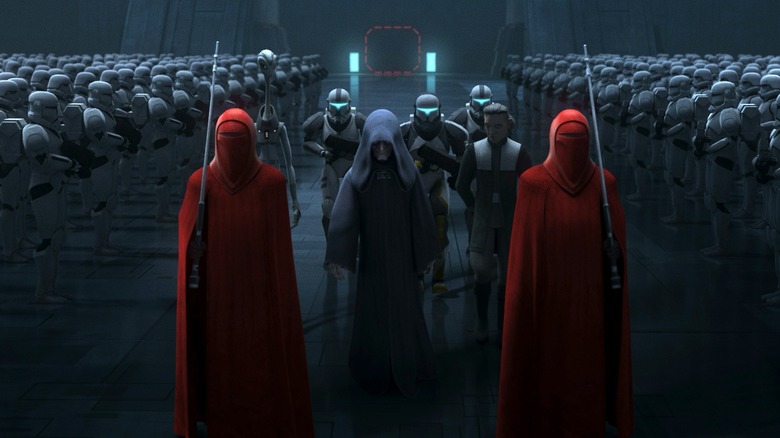What Is M-Count & Project Necromancer In Star Wars? Here's What You Need To Know
A long time ago, in a galaxy far, far away, the Force was simply a magical energy field present in all living things. It surrounded us, penetrated us, and bound the galaxy together. Then "Star Wars: Episode I — The Phantom Menace" came out, and George Lucas introduced us all to the concept of midi-chlorians, and a lot of people didn't like that very much.
Essentially, midi-chlorians are microscopic organisms that connect other lifeforms to the Force. The more midi-chlorians you have in your blood, the more natural your affinity for Force use. The prequels generated a major backlash against this idea because some fans felt it cheapened the magical mystery of the Force. Perhaps as a result, Disney has seemed trepidatious about name-dropping midi-chlorians ever since purchasing Lucasfilm. Instead, modern Star Wars projects will often refer to a lifeform's "m-count," a shortening of "midi-chlorian count" less likely to trigger fan outrage.
M-counts have been getting more and more attention lately as "Star Wars: The Bad Batch" dives deeper into the Empire's secret cloning experiments and Project Necromancer — a mysterious initiative first mentioned at the end of "The Mandalorian" Season 3. These ideas are connected because Project Necromancer revolves around Force-sensitive cloning, the very reason that Moff Gideon originally hunted Grogu. Across various points in the timeline, Star Wars has been slowly building out a cohesive lore for Palpatine's dark Force experiments, all of which culminate in "Star Wars: Episode IX — The Rise of Skywalker."
M-counts, necromancers, and the great Rise of Skywalker reparative project
"Somehow, Palpatine returned." That three-word line has haunted Star Wars ever since "The Rise of Skywalker" premiered in December 2019. Whether you loved or hated "The Last Jedi," Darth Sidious' inexplicable return from the dead left most fans baffled and, in some cases, enraged. It felt like lazy writing — a cheap way to shoehorn in some nostalgic goodwill after the most divisive film in the history of the franchise. Ever since, Lucasfilm has been slowly and steadily building out the Star Wars lore to make Palaptine's return easier to swallow.
Project Necromancer is a huge part of that reparative project. Though it's yet to be explored in full detail, the name — a reference to wizards who can resurrect and control the dead — leaves a clear impression. "The Bad Batch" reveals that from the moment he becomes emperor, Palpatine is fixated on Force-sensitive cloning. He has Kaminoan scientist Nala Se kidnapped and commissions the evil scientist Royce Hemlock to begin new cloning experiments.
The end goal of Project Necromancer is obvious: immortality. Palpatine seeks a way to turn his temporary rule into eternal power. M-counts are significant because midi-chlorian-rich genetic material makes for better Force-sensitive cloning stock. That's part of why the Imperial Remnant searches for Grogu in "The Mandalorian." During Season 3 of that series, a meeting of the remnant's secret "Shadow Council" takes place where it's implied that Project Necromancer is the long game. It takes him decades, but Palpatine ultimately succeeds as a king of resurrection through cloning.
Project Necromancer fits with Palpatine's immortality obsession
It's easy to write off Project Necromancer and its appearances in "The Mandalorian" and "The Bad Batch" as cheap efforts to justify reactionary writing in "The Rise of Skywalker." But regardless of the creative reasons behind it, it does make sense within the larger Emperor Palpatine story. In the prequel trilogy, it's clear that Sidious is obsessed with immortality. It's not just a carrot he dangles in front of Anakin Skywalker to lead him to the dark side, but a fixation that he is unable to shake. He dreams of an eternal Sith Empire in which he reigns as the undying embodiment of the dark side. And with more than two decades between "Revenge of the Sith" and "Return of the Jedi," he has more than enough time and resources to invest properly in a dark Force cloning operation.
Snoke, Rey, and any number of as-yet-unseen Star Wars storylines are all the result of Project Necromancer. More and more, the sequel trilogy is being retroactively transformed into a saga about how distorting the natural balance of things distorts the universe itself. By insisting on not only perpetuating evil, but also living well beyond when he should have died, Palpatine creates a wound at the center of the galaxy. Whether or not that idea makes "The Rise of Skywalker" any better will be up for individual fans to decide, but it certainly adds some interesting context to a film that desperately needed it.


